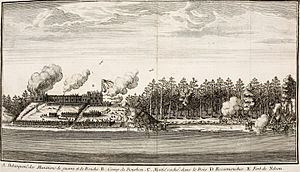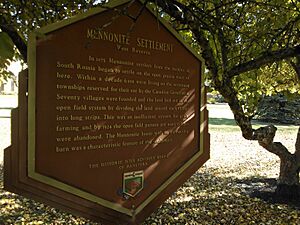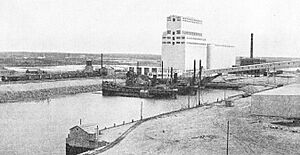History of Manitoba facts for kids
The history of Manitoba tells the story of this Canadian province, from thousands of years ago when the first people arrived, to today. Long before Europeans came, different First Nations lived here. When European fur traders arrived in the late 1600s, they built strong trade connections with these groups. The French, led by Pierre Gaultier de Varennes, sieur de La Vérendrye, set up several trading forts. In 1670, Britain claimed a large area around Hudson's Bay, called Rupert's Land. The Hudson's Bay Company was given control over all trade in this vast territory.
After the French and Indian War in 1763, France gave up its lands in North America to the British. This ended the competition between European powers in the North-West. The Hudson's Bay Company then expanded its trading posts into areas where the French had been. In 1811, Lord Selkirk started the first farming settlement in Rupert's Land, called the Red River Colony, near the Red River of the North. In 1817, Saulteaux Chief Peguis and other First Nations leaders agreed to share land with Selkirk's settlers. The Treaty of 1818 set the 49th parallel north as the border between Rupert's Land and the United States, moving some land south of the line to the U.S.
In 1870, Rupert's Land was transferred from Britain to the Government of Canada, becoming part of the North-West Territories. Because of the Red River Rebellion, the province of Manitoba was created around the Red River Colony. Canada then began signing Numbered Treaties with First Nations to settle land claims and open up land for new settlers. Manitoba was the first province formed from the North-West Territories. Its borders grew in 1881 and again in 1912 to reach its current size. For a long time, Manitoba's economy relied on farming, like growing grains and raising cattle. Today, the economy is more varied due to cities growing.
Contents
Early History of Manitoba
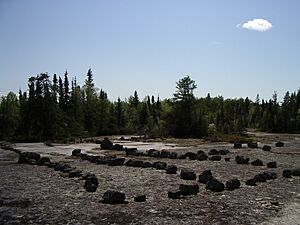
The land that is now Manitoba was first settled by First Nations people about 10,000 years ago. This was after the last glaciers from the ice age melted away in the southwest. The first land to appear was the Turtle Mountain area. Early humans in southern Manitoba left behind many clues about their lives. These include pottery pieces, spear and arrowheads, copper tools, and petroforms (stone shapes). They also left signs of farming along the Red River near Lockport, where they grew corn and other crops.
Over time, different First Nations groups lived here, including the Ojibwa, Cree, Dene, Sioux, Mandan, and Assiniboine. Other tribes also visited the area for trade. There were many trails on land and water that were part of a large trading network. The Whiteshell Provincial Park area, along the Winnipeg River, has many old petroforms. This spot might have been a trading center or a place for learning and sharing knowledge for over 2,000 years. Things like cowry shells and copper show that trade happened across long distances, reaching the oceans and larger native civilizations to the south.
In Northern Manitoba, there were places where people mined quartz to make arrowheads. Humans have lived in this region for thousands of years, leaving behind many clues about their ancient ways of life.
European Explorers Arrive
Henry Hudson was one of the first Europeans to sail into what is now Hudson Bay in 1611. The first European to reach northern Manitoba was Sir Thomas Button in 1612, who named the Nelson River. Button was looking for a trade route to China. Henry Kelsey was the first European to travel from Hudson Bay to the prairies. He reported seeing buffalo and grizzly bears, going as far as present-day Saskatchewan. The Hudson's Bay Company traded with First Nations fur traders who traveled widely by canoe along Manitoba's many rivers. Europeans first called this area Rupert's Land, which included all the lands drained by rivers flowing into Hudson Bay. Pierre Gaultier de Varennes, sieur de La Vérendrye visited the Red River Valley in the 1730s. He helped open the area for French exploration and trade. As French explorers moved in, a company from Montreal, the North West Company, began trading with the Métis.
In 1668–1669, the British ship Nonsuch sailed into Hudson Bay. This was the first fur trading ship to reach the area. This trip led to the creation of the Hudson's Bay Company. The British government gave this company total control over the entire Hudson Bay watershed. This land was named Rupert's Land after Prince Rupert, who helped fund the company. York Factory was built in 1684. It replaced Fort Nelson, the Hudson's Bay Company's first fort, which was destroyed by French traders. After the Battle of Hudson's Bay, French forces briefly took over York Factory. Both the North West Company and the Hudson's Bay Company built fur trading forts along the rivers and lakes. They often competed fiercely, especially in the southern areas.
The name "Manitoba" has a few possible origins. Most likely, it comes from the Cree or Ojibwe languages. It means "strait of the Manitou (spirit)." It might also come from the Assiniboine language, meaning "Lake of the Prairie."
Manitoba Becomes British Territory
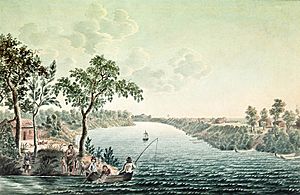
Great Britain gained control of this territory in 1763. This happened after they won the Seven Years' War (also known as the French and Indian War; 1754–1763) against France. At that time, the territory included Rupert's Land, which covered the entire Hudson Bay watershed. Most rivers and waters in Manitoba flow north, eventually emptying into Hudson Bay. The Hudson's Bay Archives, located in Winnipeg, Manitoba, keeps the rich history of the fur trade.
In 1812, Lord Selkirk founded the first farming community, the Red River Colony. This settlement was just north of what is now downtown Winnipeg. This led to conflicts between the British settlers and the Métis people. There were also fights between the fur trading companies that supported them: the Hudson's Bay Company and the North West Company. In 1816, during the Battle of Seven Oaks, twenty settlers, including the governor, and one Métis person were killed.
Lake Manitoba was named by the Cree, Ojibway, and Assiniboine people before the land to the south was named. The lake was named after the word Manitou, meaning spirit. However, the exact original words and their meanings are still a bit of a mystery. Thomas Spence was the first to suggest forming a "Republic of Manitobah" just south of Lake Manitoba. Years later, Louis Riel and others made a similar suggestion.
Manitoba Joins Canada
Rupert's Land was given to Canada in 1870 and became part of the North-West Territories. The Métis people of the Red River valley felt their concerns were being ignored by the new Canadian government. So, they started the Red River Rebellion led by Louis Riel. They set up a provisional government and named the area Manitoba. Talks between this provisional government and the Canadian government led to the Manitoba Act. This act created the Province of Manitoba and allowed it to join Canada in 1870. Because of the rebellion, Louis Riel was pursued by British army officer Garnet Wolseley, and Riel had to flee into exile.
Late 1800s in Manitoba
The new government of Manitoba was mostly controlled by English Canadians. The agreement to create the province had promised that the Métis would receive land grants and that their existing landholdings would be recognized. However, these promises were largely ignored. Instead, land went to English-speaking settlers arriving from Ontario. Because of this unfair treatment, many Métis moved to what would become Saskatchewan and Alberta.
The original province of Manitoba was very small, only about 1/18th of its current size. It was known as the "postage stamp province." Its borders were the 49th parallel (US border) to the south, 96° longitude to the east, 99° longitude to the west, and 50° 30' to the north. Its borders were expanded in 1881, taking land from the North-West Territories and the District of Keewatin. However, Ontario claimed a large part of the Keewatin land, which was given to Ontario in 1889. Manitoba grew to its current size in 1912, gaining land from the Northwest Territories to reach 60°N. This made its northern border the same as its western neighbors, Saskatchewan, Alberta, and British Columbia.
In 1874 and 1876, two areas in southern Manitoba, the East Reserve and West Reserve, were set aside for Russian Mennonite settlers. In the following years, thousands of Mennonites moved to the area. They made up a large part of the province's population. In 1875, a group of Icelandic immigrants settled in Gimli, on the west shore of Lake Winnipeg. They founded the community of New Iceland. This became the largest settlement of Icelanders outside of Iceland itself.
Numbered Treaties were signed in the late 1800s with the chiefs of various First Nations living in the area. These treaties made specific promises of land for every family. As a result, a reserve system was set up under the control of the Government of Canada. The promised amount of land was not always given to the First Nations. This has led to ongoing efforts by Indigenous groups to claim their rights to the land through aboriginal land claims.
Manitoba Schools Question
The Manitoba Schools Question showed deep differences in cultural values in the territory. It became an important national issue. Catholic Franco-Manitobains had been promised a government-supported separate school system in Manitoba's original constitution. This meant their children would be taught in French. However, a movement among English Protestants from 1888 to 1890 demanded an end to French schools. In 1890, the Manitoba legislature passed a law that stopped funding for French Catholic schools. The French Catholic minority asked the federal government for help. But groups like the Orange Order and other anti-Catholic forces across Canada opposed them.
The federal Conservatives tried to pass a law to overrule Manitoba. But they were blocked by the Liberals, led by Wilfrid Laurier. Laurier opposed the law because he believed in provincial rights. The Manitoba Schools issue became important in the 1896 Canadian federal election. It worked against the Conservatives and helped elect the Liberals. As Prime Minister, Laurier found a compromise. It stated that Catholics in Manitoba could have their own religious instruction for 30 minutes at the end of the day, if there were enough students to make it worthwhile in a school.
Manitoba in the 1900s
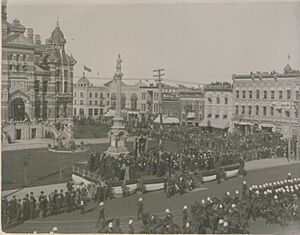
By the early 1900s, Winnipeg had become the third-largest city in Canada. This boomtown grew very quickly from the late 1800s to the early 1900s. There were many outside investors, lots of immigration, new railways, and business was thriving. Even today, you can see the many old mansions that belonged to Winnipeg's growing wealthy class. When the Manitoba Legislature was built, people expected Manitoba's population to reach 3 million very soon. Around the time of the First World War, the fast growth of the city slowed down. Large amounts of money were no longer invested as much as before the war. Winnipeg eventually fell behind in growth as other major Canadian cities, like Calgary today, began to grow faster.

After the First World War ended, there was a lot of unhappiness among farmers (about wheat prices) and union members (about wages). This led to a rise in radical ideas. The most dramatic event was the Winnipeg General Strike of 1919. This strike shut down most activities for six weeks, starting on May 15. The strike ended on June 25, 1919, as workers slowly returned to their jobs. The main goals of the strike were to get fair wages and allow workers to bargain together. It also tested a new way of protesting: a general strike, which aimed to pressure employers through the public. Some people worried the strike was a step towards workers taking power in the community. In the end, eight strike leaders were put on trial. Most were found guilty of charges like planning to cause rebellion. Four foreign-born leaders were sent out of Canada. After this, organized labor in Manitoba became weaker and divided.
Meanwhile, farmers in the province were organizing the United Farmers of Manitoba (UFM). This group ran in the 1920 provincial elections. The result was that no party won a majority, and no government could be formed. New elections were held in 1922 to fix this. The UFM won clearly, getting 30 out of 57 seats.
Access to Hudson Bay
Manitoba farmers were frustrated with shipping their grain through eastern ports. They pushed for their own grain port on Hudson Bay. This led to the building of the Hudson Bay Railway. It was built in stages north from The Pas after a railway bridge was built over the Saskatchewan River in 1910–1911. At first, plans considered both Churchill and Port Nelson as port locations. It was decided to go to Port Nelson in 1912. Construction began there, and a new Canadian research ship, CSS Acadia, was sent to map the port and shipping routes in the Bay. However, building the harbor at Port Nelson faced engineering and cost problems. It was abandoned during the First World War.
After the railway company went bankrupt in 1918, the federal government decided to finish the Hudson Bay Railway. This time, they built the railway line towards Churchill. CSS Acadia was sent to survey for a port there, and railway construction started again. Political and money problems, along with engineering challenges like large amounts of muskeg (boggy land) and frequent rock outcrops on the Canadian Shield, delayed the project. But the railway and port were finally completed and opened for shipping in 1929.
Great Depression and World War II
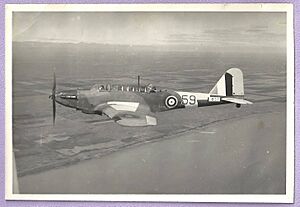
The Great Depression (1929–c.1939) hit Western Canada, including Manitoba, very hard. The collapse of the world market, combined with a big drop in farm production due to drought, forced Manitoba to change its economy. It moved away from relying only on wheat farming. The Manitoba Co-operative Commonwealth Federation, which later became the New Democratic Party of Manitoba (NDP), was founded in 1932.
Canada entered the Second World War in 1939. Winnipeg was one of the main centers for the British Commonwealth Air Training Plan, which trained fighter pilots. There were air training schools all over Manitoba. Several Manitoba-based regiments were sent overseas, including Princess Patricia's Canadian Light Infantry. To raise money for the war, the Victory Loan campaign organized "If Day" in 1942. This event showed a pretend Nazi invasion and occupation of Manitoba. It eventually raised over C$65 million for the war effort.
Manitoba in the Late 1900s
Winnipeg was flooded during the 1950 Red River Flood and part of the city had to be evacuated. In that year, the Red River reached its highest level since 1861 and flooded most of the Red River Valley. The damage from the flood led the Premier at the time, Duff Roblin, to push for building the Red River Floodway. It was finished in 1968 after six years of digging. Permanent dikes were built in eight towns south of Winnipeg, and clay dikes and diversion dams were built in the Winnipeg area.
The province celebrated its 100th anniversary of joining Canada in 1970. Princess Anne and Prince Charles led the official celebrations.
In 1990, Prime Minister Brian Mulroney tried to pass the Meech Lake Accord. This was a plan to change the constitution to get Quebec to agree to the Canada Act 1982. It needed everyone in the legislature to agree to avoid public discussion. Manitoba politician Elijah Harper, a Cree, opposed it. He believed First Nations had not been properly included in the Accord's process. Because of his opposition, the Accord failed.
In 1997, the "Flood of the Century" caused over C$400 million in damages in Manitoba. However, the floodway prevented Winnipeg from flooding.
Manitoba in the 2000s
Voters in Manitoba are often divided by where they live (rural or city), north or south, and by their background. The New Democratic Party (NDP) tends to get support from diverse and lower-income communities in Northern Manitoba and north Winnipeg. The Progressive Conservatives (PCs) usually get support from wealthier, southern parts of the province and Winnipeg. Leaders like Duff Roblin, Edward Schreyer, and Gary Doer have tried to appeal to people across these different groups. They aimed to be seen as the "progressive center" to gain control of Manitoba politics.
See also
- History of Winnipeg
- Timeline of Winnipeg history
- Timeline of Manitoba history
- List of historic places in Manitoba
- District of Saskatchewan
- Archives of Manitoba
- John Bean (explorer)
- Natural Resources Acts
- History of Canada
|


